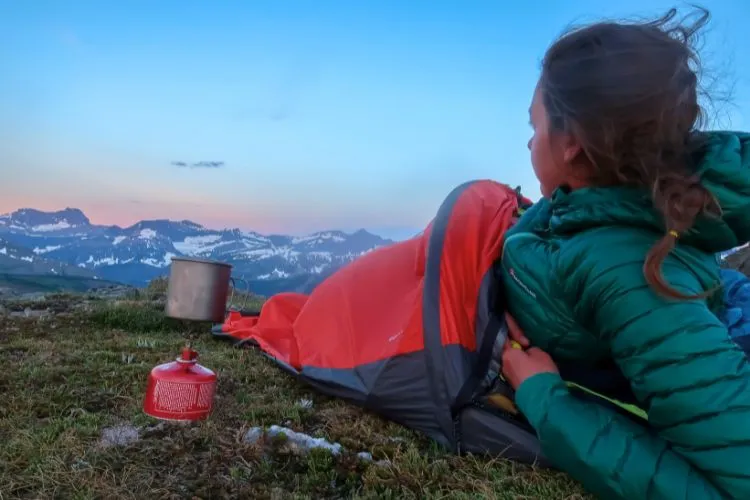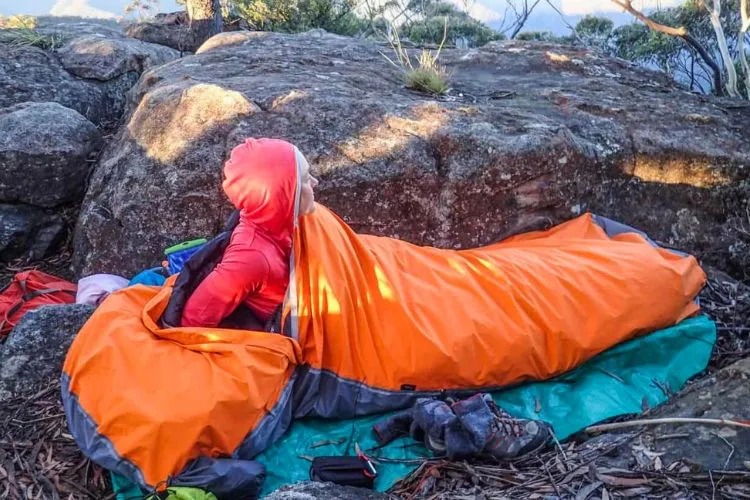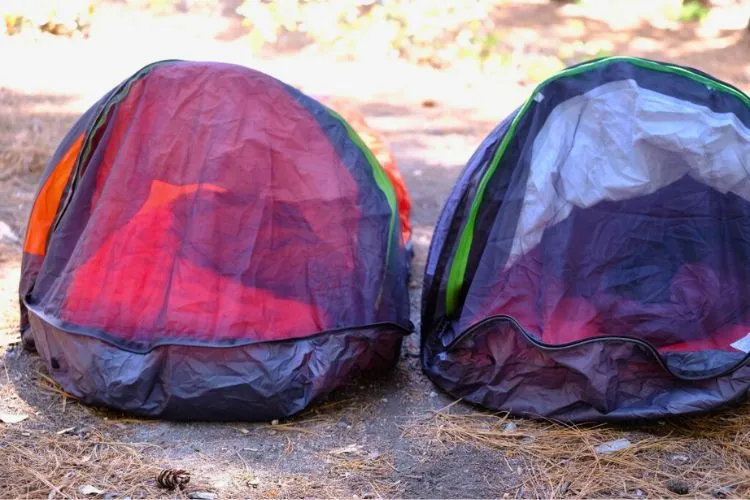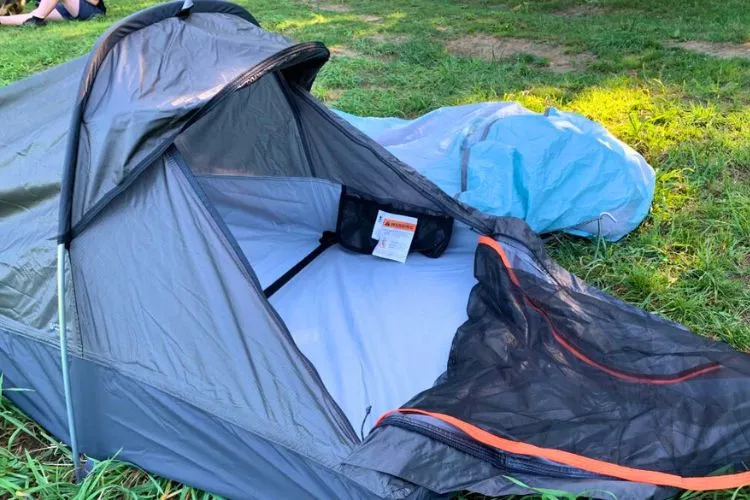When it comes to outdoor adventures, having reliable shelter is crucial. One popular option for those seeking a lightweight and convenient alternative to traditional tents is the bivy sack.
But, what is a bivy sack?
In this comprehensive guide, we will explore about bivy sack, its benefits, the different types available, key factors to consider when choosing one, and pro tips for using and maintaining your bivy sack.

what is a bivy sack?
A bivy sack, short for bivouac sack, is a minimalist outdoor shelter that provides protection from the elements during camping or outdoor activities.
It is a lightweight and compact alternative to traditional tents.
A bivy sack is essentially a waterproof and breathable bag that covers your sleeping bag, creating a barrier between you and the environment.
It is designed to keep you dry and protected from rain, wind, and snow while allowing for ventilation to reduce condensation.
Bivy sacks are typically made from durable materials like nylon, Gore-Tex, or eVent. They are popular among backpackers, hikers, and mountaineers who value mobility, simplicity, and reducing weight.
Bivy sacks offer a quick and easy setup, making them ideal for solo campers or situations where space is limited.
Benefits of Using a Bivy Sack
Bivy sacks offer several advantages for outdoor enthusiasts:

Lightweight and Compact Design
A bivy sack is a minimalist shelter that provides a snug sleeping space while keeping weight to a minimum. Compared to tents, bivy sacks are incredibly lightweight, making them an ideal choice for backpackers and hikers who prioritize reducing pack weight.
Enhanced Weather Protection
Designed to withstand various weather conditions, bivy sacks offer excellent protection against rain, wind, and snow. Most bivy sacks are made from waterproof and breathable materials, ensuring you stay dry and comfortable even in inclement weather.
Versatility for Different Outdoor Activities
Whether you are embarking on a multi-day hiking trip, mountaineering expedition, or simply spending a night under the stars, bivy sacks are versatile and can be used in a variety of outdoor scenarios. They are particularly useful when camping in areas with limited space or uneven terrain.
Types of Bivy Sacks

Basic Bivy Sacks
These entry-level bivy sacks are straightforward in design and provide a lightweight yet effective shelter option.
They typically feature a waterproof shell made of nylon or other durable materials to keep you dry during rainy conditions. Basic bivy sacks often incorporate a small hoop at the head area to provide additional space and airflow.
Minimalist Bivy Sacks
Designed for ultralight backpacking and fast-and-light adventures, minimalist bivy sacks are stripped down to the essentials, focusing on reducing weight and pack size.
They offer minimal features and maximum weight savings, making them an excellent choice for experienced outdoor enthusiasts who appreciate simplicity.
Four-Season Bivy Sacks
For those seeking adventure in extreme weather conditions and high altitudes, four-season bivy sacks provide the utmost protection against harsh elements. These bivy sacks often come with reinforced construction, insulated materials, and a more spacious design to accommodate winter gear and thicker sleeping bags.
Factors to Consider When Choosing a Bivy Sack

Size and Weight
Before purchasing a bivy sack, consider your preferred sleeping position and the amount of space you need. Different bivy sacks have varying dimensions, so ensure it offers enough room for you to be comfortable.
Material and Waterproofing
Check the materials used in the bivy sack’s construction. Most bivy sacks are made from waterproof and breathable fabrics like Gore-Tex or eVent. Ensure the sack is properly seam-sealed to prevent moisture from seeping in.
Ventilation and Breathability
Good ventilation is crucial to prevent condensation build-up inside your bivy sack. Look for models with integrated mesh panels or vents to allow air circulation and reduce the likelihood of condensation.
Durability and Longevity
Investing in a durable bivy sack is essential for long-term use. Consider the quality of the materials, stitching, and zippers to ensure your bivy sack can withstand the rigors of outdoor adventures.
Integrated Features
Some bivy sacks come with additional features such as built-in bug netting or a hoop system that provides extra headspace. Consider whether these features are important to you based on your preferences and intended use.
Price Range and Budget Considerations
Bivy sacks are available in a wide price range, depending on their features, materials, and brand. Set a budget and consider the value-for-money aspect when making your final decision.
What are the pros and cons of using a bivy sack?

Pros
- Lightweight and compact design
- Enhanced weather protection
- Versatility for different outdoor activities
- Quick and easy setup
Cons
- Limited space and headroom
- Condensation build-up in certain conditions
- Less comfort compared to tents
Tips for Using and Maintaining a Bivy Sack
- Proper setup and positioning: Choose a flat and dry area, and align your bivy sack to ensure optimal shelter and ventilation.
- Precautions for condensation and moisture management: Open vents, adapt your clothing to reduce sweat, and use moisture-absorbing materials inside the bivy sack.
- Cleaning and storage recommendations: Regularly clean your bivy sack according to the manufacturer’s instructions and store it in a dry and well-ventilated area.
- Repairing minor damages and extending the lifespan: Carry a repair kit and patch minor tears promptly to avoid compromising the bivy sack’s waterproofing and durability.
Frequently Asked Questions (FAQs)
What is a bivy sack used for?
A bivy sack is a minimalist shelter used for camping or outdoor activities where simplicity, low weight, and small pack size are priorities. It offers protection from the elements while providing a lightweight alternative to traditional tents.
What materials are bivy sacks made of?
Bivy sacks are typically made from durable and waterproof materials such as nylon, Gore-Tex, or eVent. These fabrics ensure breathability to prevent condensation buildup inside the sack.
Can a bivy sack replace a tent?
While bivy sacks offer more compact and lightweight options, they may not provide the same level of comfort and space as a tent. Bivy sacks are best suited for solo campers or those who prioritize minimalism and mobility.
How does a bivy sack differ from a sleeping bag?
A bivy sack is an outer shell that provides protection and a waterproof barrier between you and the environment. It is often used in conjunction with a sleeping bag, which provides warmth and insulation. A bivy sack can enhance the performance of a sleeping bag by adding an extra layer of protection from moisture and wind.
Conclusion:
Bivy sacks offer outdoor enthusiasts a lightweight and versatile shelter option, protecting against the elements while reducing pack weight. By considering factors such as size, materials, and intended use, you can choose a bivy sack that best suits your needs.
With proper setup and maintenance, your bivy sack will serve you well on countless adventures, enhancing your camping experience and enabling you to fully immerse yourself in the beauty of the great outdoors.
Remember, a bivy sack provides a sense of adventure and a closer connection with nature, offering an unforgettable experience for those who dare to venture off the beaten path. So, pack your bivy sack, grab your gear, and embark on your next thrilling outdoor adventure!


